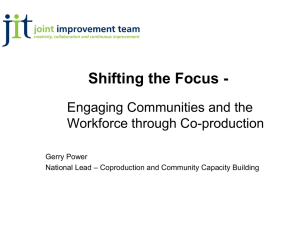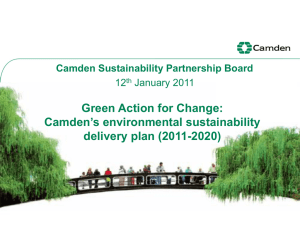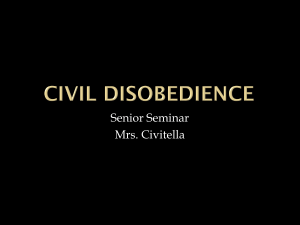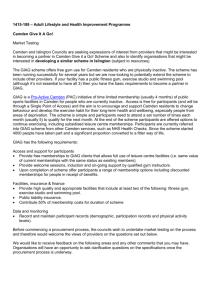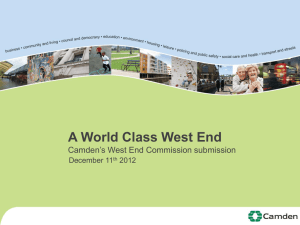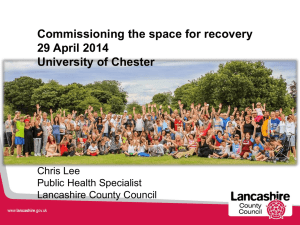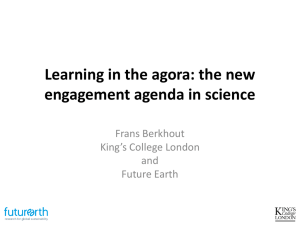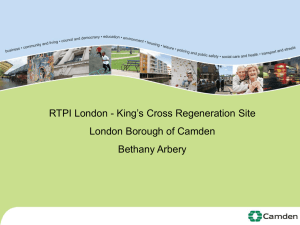Camden Commissioning Case Study (doc - 48Kb)
advertisement
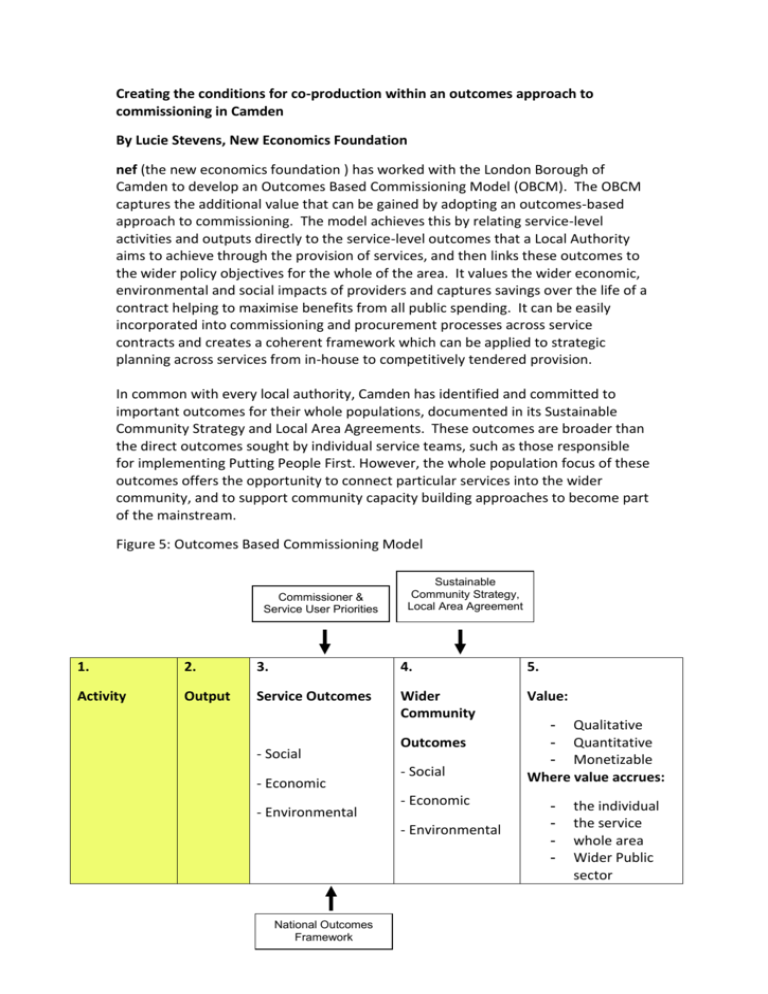
Creating the conditions for co-production within an outcomes approach to commissioning in Camden By Lucie Stevens, New Economics Foundation nef (the new economics foundation ) has worked with the London Borough of Camden to develop an Outcomes Based Commissioning Model (OBCM). The OBCM captures the additional value that can be gained by adopting an outcomes-based approach to commissioning. The model achieves this by relating service-level activities and outputs directly to the service-level outcomes that a Local Authority aims to achieve through the provision of services, and then links these outcomes to the wider policy objectives for the whole of the area. It values the wider economic, environmental and social impacts of providers and captures savings over the life of a contract helping to maximise benefits from all public spending. It can be easily incorporated into commissioning and procurement processes across service contracts and creates a coherent framework which can be applied to strategic planning across services from in-house to competitively tendered provision. In common with every local authority, Camden has identified and committed to important outcomes for their whole populations, documented in its Sustainable Community Strategy and Local Area Agreements. These outcomes are broader than the direct outcomes sought by individual service teams, such as those responsible for implementing Putting People First. However, the whole population focus of these outcomes offers the opportunity to connect particular services into the wider community, and to support community capacity building approaches to become part of the mainstream. Figure 5: Outcomes Based Commissioning Model Commissioner & Service User Priorities Sustainable Community Strategy, Local Area Agreement 1. 2. 3. 4. 5. Activity Output Service Outcomes Wider Community Value: - Social - Economic - Environmental Outcomes - Social - Economic - Environmental National Outcomes Framework - Qualitative - Quantitative - Monetizable Where value accrues: - the individual the service whole area Wider Public sector Figure 5 illustrates the outcomes based commissioning model. Reading from left to right across the framework it describes: How activities and outputs (columns 1 & 2) delivered as part of the service contribute to the desired service-level outcomes (column 3) established by service-users, other stakeholders and commissioners. How these service level outcomes relate to the areas wider community outcomes (column 4) as reflected in the Sustainable Communities Strategy and Local Area Agreement (social, economic and environmental outcomes). How the council will monitor the additional value and benefits created through the delivery of this service (column 5). Value can be measured in qualitative, quantitative or financial terms. It is also recognised that value will not just accrue to the service, but also to individuals and communities, across the council, its partners and to the wider public sector. Being able to describe services in this format explicitly: Links the commissioning process and service level activities to the wider strategic goals for the area. Takes an outcomes-based approach to commissioning services which consistently focuses attention on achieving sustainability for all services i.e. social, economic and environmental outcomes. Incorporates an outcome-based performance framework for monitoring and tracking outcomes. Increases opportunities for innovation by moving to describing outcomes as opposed to prescribing activities. Embedding co-production in the outcomes based approach Within the commissioning process for its Mental Health Day Services contract, commissioners in Camden did not set out in great detail the activities which had to be delivered by potential services providers. Instead, they made clear the total financial value of the contract and explicitly set out its intention to procure services that are co-designed and co-produced. This allowed potential providers to work with local people and local resources to shape activities that were important to them and would result in the outcomes set out. It was vital that co-production was explicitly described in the service specification, so that this became part of the subject matter of the service being contracted. This allowed commissioners to judge tenders on the basis of their capacity to co-produce, incorporating this as part of the value for money that they represent. Defining co-production within the service specification is important for providers and commissioners. The following text was used by Camden Borough Council in the Mental Health Day Care Service: ‘We would encourage providers to adopt the model of ‘co-production’ whereby services are planned and delivered in mutually beneficial ways that acknowledge and reward local ‘lay’ experience while continuing to value professional expertise. Service users should be regarded as an asset and encouraged to work alongside professionals as partners in the delivery of services. Co-production requires professionals and service managers to move out of traditional roles as ‘experts’ and ‘providers’ into partnership models that work with ‘clients’ and ‘communities’. This enables them to find a solution together to the complexity of their problem and sometimes requires that the ‘problem’ be redefined. Real and lasting changes are possible with approaches that build or strengthen social networks and in turn motivate people to learn about and exercise their powers and their responsibilities as citizens. Networks of friends and families should also be considered positive co-contributors to success in this approach.’ Prompts were also included in Camden’s service specification to provide guidance about the type of activity that would encourage co-production and community capacity building within services. In Camden these included: Increase community participation To facilitate access to and involve existing community resources and networks as a core element of the services To increase the capacity of community resources and reduce stigma and discrimination in order to enable service users access to mainstream services and facilities To build new social networks Improve social inclusion to encourage and facilitate opportunities to extend positive social networks to enable users to build positive social networks outside service settings Maximise involvement of users and carers to maximise the use of the experience of those with a personal experience of services to encourage and involve user and carer involvement in designing and delivering services, including those who may not be using existing services because they find them inaccessible or unacceptable to encourage people who are not accessing current services and increase the extent to which services are led and run by people with an experience of services themselves In order that commissioners were able to track and evaluate the extent to which coproduction is proposed within tenders they included targeted questions against which to assess potential providers capacity to co-produce services. The responses to these questions were included and judged within the scoring process (within the ‘quality’ aspect of the tender). The questions included; How does your service identify and mobilise service user’s strengths? Please illustrate your answer with reference to previous contracts. How does your service support people in finding ways to help/ support others, including fellow service users, family, neighbours and the local community. Please illustrate your answer with reference to previous contracts. What role do you envisage for service users’, carers, family, peer group, neighbours and the wider community in the provision of your service. How would this contribution be measured or rewarded? What work will your service play in engaging other statutory and nonstatutory agencies in enhancing service users’ well-being? Please illustrate your answer from previous experience. The winning tender was a consortium of Camden based third sector organisations, MIND in Camden, Holy Cross Centre Trust (HCCT) and Camden Volunteer Bureau, a mainstream volunteering organisation. The consortium advocated a co-production approach to running the service, which uses time banking1 and peer support approaches to create a mutually supportive network of people in and around the providers. By treating service users and the wider Kings Cross community as potential assets, rather than as passive recipients, the consortium delivering Camden’s day care services has been able to leverage previously invisible or neglected resources – the capacities and knowledge of service users and the wider community itself, who provide support to each other, anything from advice to gardening and lifts. It has enabled the consortium to focus on the broader social, environmental and economic aspects of the services, as well as to focus on preventative work that encourages independence and inclusion in mainstream community activity amongst those dealing with mental health issues2. The OBCM is an approach which identifies ways in which more sustainable, joined-up procurement can help the Council to meet multiple social, environmental and economic goals via its procurement processes. Applying the OBCM also results in: Stimulating Innovation: By focusing on desired outcomes, the OBCM opens the space for innovation, allowing providers and people using services to bring their own unique added-value to designing and delivering the service. The process supports providers to work in partnership with commissioners and service-users, building on their assets as well as meeting their needs, using a ‘co-production’ approach. 1 For more on timebanking see http://www.timebanking.org/ and http://www.justaddspice.org Harrington, R. and Ryan-Collins, J. (2009) Users as producers: innovation and co-production in Camden. In Parker, S. (Ed) ‘More than Good Ideas’. London: IDeA. 2 Value for Money: By focusing Council spend on the longer term economic, environmental and social outcomes it is seeking commissioners will maximize the impact of every pound spent. This will enable them to find more effective ways of delivering services including building in preventative approaches, saving money and improving outcomes for local citizens. The valuing component of the model will explicitly capture the savings achieved through delivering the service over the life of the contract and highlight where savings are generated for other services. In so doing, the OBCM will enable commissioners to better demonstrate the longer term Value for Money their services are achieving. Achieving better outcomes: Clearly identifying the outcomes sought and how they will be measured and monitored throughout the contract period will result in a body of evidence that supports continuous improvement and helps drive innovation in other services. The involvement of service-users in the design and delivery of the service and in the monitoring process will enable better and broader understanding of the value of the changes supported by services. Camden is now using the outcome model with a home care service for people with dementia worth £3 million over three years and will be using it across all of their Supporting People and related social services. The total contractual value of services employing the outcome model between 2008 and 2010 is approximately £30 million3. 3 Reference Camden’s Outcomes document for ADASS 2008
